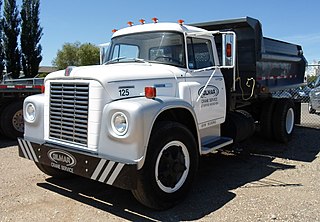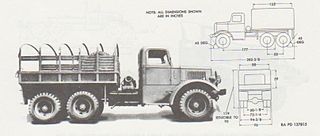
Mack Trucks, Inc., is an American truck manufacturing company and a former manufacturer of buses and trolley buses. Founded in 1900 as the Mack Brothers Company, it manufactured its first truck in 1905 and adopted its present name in 1922. Mack Trucks is a subsidiary of AB Volvo, which purchased Mack along with its then parent company Renault Véhicules Industriels in 2000.

The Studebaker US6 (G630) was a series of 2+1⁄2-ton 6×6 and 5-ton 6×4 trucks manufactured by the Studebaker Corporation and REO Motor Car Company during World War II. The basic cargo version was designed to transport a 2+1⁄2-short-ton cargo load over any type of terrain in any weather. Most of these were exported to the Soviet Union under Lend-Lease by the USA during World War II, since the competing GMC 6×6 CCKW design proved to be more suitable for Western Front conditions.

The Diamond T Company was an American automobile and truck manufacturer. They produced commercial and military trucks.

The E series Studebaker trucks are the original 1955 E series Studebaker trucks, sold in half-ton, 3/4-ton, and 1-, 1.5-, and 2-ton capacities, and the 1956: 2E series; 1957-58: 3E series; 1959: 4E series; 1960: 5E series; 1961: 6E series; 1962: 7E series; and 1963-64: 8E series. Given these model-year designations, "E series" has come to mean all Studebaker trucks built between 1955 and the end of all vehicle production in the US in December 1963. Within each tonnage rating, these trucks were all fairly similar, since Studebaker was in dire financial straits during this entire period and invested virtually nothing to update its truck division products. For the 1956 and 1957-58 models, all Studebaker trucks were called Transtar.

The M39 series 5-ton 6×6 truck (G744) was a family of heavy tactical trucks built for the United States Armed Forces. The basic cargo version was designed to transport a 5-ton (4,500 kg), 14 ft (4.3 m) long load over all terrain in all weather. In on-road service the load weight was doubled.

The International Loadstar is a series of trucks that were produced by International Harvester from 1962 to 1978. The first product line of the company developed specifically as a medium-duty truck, the Loadstar was slotted between C-Line pickup trucks and the heavy-duty R-series. Following the discontinuation of the R-series, the Loadstar was slotted below the Fleetstar and Transtar conventionals.

The GMC CCKW, also known as "Jimmy", or the G-508 by its Ordnance Supply Catalog nr, was a highly successful series of off-road capable, 21⁄2-ton, 6×6 trucks, built in large numbers to a standardized design for the U.S. Army, that saw heavy service, predominantly as cargo trucks, in both World War II and the Korean War. The original "Deuce and a Half", it formed the backbone of the famed Red Ball Express that kept Allied armies supplied as they pushed eastward after the Normandy invasion.
Continental Motors Company was an American manufacturer of internal combustion engines. The company produced engines as a supplier to many independent manufacturers of automobiles, tractors, trucks, and stationary equipment from the 1900s through the 1960s. Continental Motors also produced automobiles in 1932–1933 under the name Continental Automobile Company. The Continental Aircraft Engine Company was formed in 1929 to develop and produce its aircraft engines, and would become the core business of Continental Motors, Inc.

The G-506 trucks, 1+1⁄2-ton, 4x4, produced as the Chevrolet G7100 models, were a series of (light) medium four wheel drive trucks used by the United States Army and its allies during and after World War II. This series came in standard cargo, as well as many specialist type bodies.

The M915 is a tractor unit used for line haul missions by the United States Army. Designed for use on improved roads it does not have a driven front axle.

The Mack NO 7+1⁄2-ton 6x6 truck was a heavy 6x6 cargo truck designed in the 1940s by the American manufacturer Mack Trucks. It was used by the U.S. Army as an artillery tractor for heavy artillery during and after World War II. The official U.S. Army designation was: Truck, 7 1/2 ton, 6x6, Prime Mover. Its G-number was (G-532).

The Mack model EH trucks were a family of 4x2 trucks used by the US and British military before and during World War II. They were built in conventional and cab-over-engine models and were used as both trucks and semi-tractors. Originally a commercial design, in 1943 a military version became standard.

The M425 and M426 Tractor trucks (G671) were 5 ton (4,536kg) load rated 4x2 semi-tractors that were used from 1944 on by the US Army. They are famous for the use on the Red Ball Express from Normandy to the front, but were also used in the China Burma India Theater. After the war they were used in Europe, including during the Berlin Crisis, and in the Korean War.

The Mack M123 (G792) was a 10-ton 6x6 semi-tractor introduced in 1955. The Mack M125 was a heavy cargo truck version of the M123. The M123 was used to tow tank transporter trailers while the M125 towed field artillery pieces.

The Mack NJU 5- to 6-ton 4x4 Ponton tractor (G639) was a semi-tractor designed to haul bridging equipment during World War II. Of the 700 built 119 were supplied to the British in Egypt, 8 were built with van bodies, and the rest were used as a substitute standard by the US Army.

The Mack NM 6-ton 6x6 truck, officially "Prime Mover Cargo truck (G-535)", was Mack's first military 6x6. It debuted as a prime mover in 1940, and was used for towing AA guns, and ammunition. Gun crews rode in its canvas covered bed. The NM's enclosed cab came from the commercial L-model. Many NM's were used by the British as recovery vehicles.

The Autocar Model U8144T, officially "5- to 6-Ton, 4×4, Ponton Tractor Truck", was the largest, and most heavy-duty, of a family of heavy four-wheel drive trucks developed for, and deployed primarily with, the United States Army in World War II. They were of a "cab over engine" design, and produced by the Autocar Company from 1941 to 1945 with 2,711 being built.

The 6-ton 6×6 truck was a family of heavy tactical trucks built for the United States Army during World War II. The basic cargo version was designed to transport a 6- short ton (5,400 kg) cargo load over all terrain in all weather. The chassis were built by Brockway Motor Company, The Corbitt Company, The Four Wheel Drive Auto Company (FWD), Ward LaFrance Truck Corporation, and White Motor Company. They were replaced by the M54 5-ton 6x6 trucks in the 1950s.

The 5‑ton 6x6 truck, officially "Truck, 5-ton, 6x6", was a class of heavy-duty six-wheel drive trucks used by the US Armed Forces. The basic cargo version was designed to transport a 5-ton (4,500 kg) load over all roads and cross-country terrain in all weather. Through three evolutionary series there have been component improvements, but all trucks were mechanically very similar. They were the standard heavy-duty truck of the US military for 40 years, until replaced by the Medium Tactical Vehicle (MTV) beginning in 1991.

The Kenworth 10-ton 6x6 heavy wrecking truck (G116) was the standard heavy wrecker of the US Army during World War II. It was replaced in the 1950s by 5-ton wreckers.




























